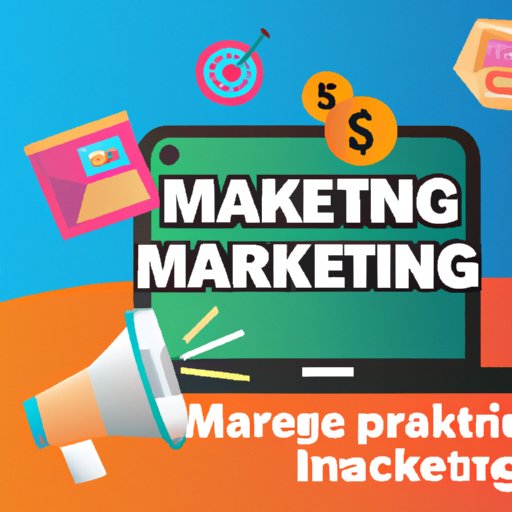Introduction
As a small business owner, you know how difficult it can be to stand out from the competition. You may not have the same resources as larger companies, but with the right strategies, you can successfully market your business and increase its visibility. In this article, we’ll explore how to effectively market your small business.
But first, let’s define what constitutes a small business. According to the U.S. Small Business Administration, a small business is defined as one that has fewer than 500 employees. Small businesses are often privately owned, operated by one or two owners, and have limited resources. As such, they need to get creative when it comes to marketing.
Develop a Comprehensive Social Media Strategy
Social media has become an essential tool for businesses of all sizes. It’s a great way to engage with customers, build brand awareness, and promote products and services. To make the most of social media, you need to develop a comprehensive strategy.
Identify Your Target Audience
The first step in creating a social media strategy is to identify your target audience. Who are you trying to reach? What are their interests, needs, and wants? Understanding who you’re targeting will help you craft effective messages and choose the right platforms.
Choose Your Platforms
Once you’ve identified your target audience, you need to decide which platforms to use. The most popular platforms include Facebook, Twitter, Instagram, LinkedIn, and YouTube. Choose the ones that best fit your goals and target audience. For example, if you’re targeting young professionals, LinkedIn might be the best choice.
Set Objectives and Goals
Having clear objectives and goals will help you stay focused and measure your progress. Do you want to increase brand awareness? Drive traffic to your website? Generate leads? Set specific, achievable goals and track your progress.
Track Results
Tracking results is essential for understanding what’s working and what’s not. Use analytics tools to measure engagement, such as likes, shares, comments, and followers. This will help you determine which posts are most successful so you can focus on creating similar content.
Utilize Search Engine Optimization (SEO)
Search engine optimization (SEO) is the process of optimizing your website for search engines like Google and Bing. By optimizing your website for search engines, you can improve your rankings and drive more organic traffic to your site.
Research Keywords
The first step in SEO is keyword research. Identify the keywords that your target audience is searching for and incorporate them into your website’s content. This will help search engines understand what your website is about and rank it higher in search results.
Optimize Webpages
Once you’ve identified the keywords you want to target, you need to optimize your webpages for those keywords. This includes adding the keywords to headlines, meta descriptions, image alt tags, and body text. This will help search engines understand what your website is about and rank it higher in search results.
Monitor Rankings
Tracking your rankings is key to understanding the effectiveness of your SEO efforts. Use a tool like Google Search Console to monitor your website’s performance and track your progress over time. This will help you identify areas where you can improve your SEO and stay ahead of your competition.
Leverage Influencer Marketing
Influencer marketing is a powerful tool for reaching new audiences and increasing brand awareness. It involves partnering with influencers—people who have a large following on social media—to promote your brand. Here’s how to leverage influencer marketing for your small business:
Identify Appropriate Influencers
The first step in influencer marketing is to identify appropriate influencers. Look for influencers who have a large following and whose values align with your brand. You can also use tools like BuzzSumo to search for influencers in your industry.
Collaborate with Influencers
Once you’ve identified the right influencers, you need to collaborate with them. Reach out and explain why your brand would be a good fit for them. Offer incentives, such as free products or discounts, in exchange for promotional posts. This will help you build relationships with influencers and reach new audiences.
Create a User-Friendly Website
Your website is often the first point of contact between you and potential customers. If it’s not user-friendly, visitors won’t stick around. Here’s how to create a website that engages visitors and encourages them to take action:
Design an Engaging Homepage
Your homepage should be the focal point of your website. Design it to grab attention and draw visitors in. Include visuals, like photos and videos, that tell your story and highlight your products. Keep the design simple and focus on creating an engaging experience.
Make Navigation Easy
It’s important to make navigation easy for visitors. Make sure your menu is clearly labeled and easy to find. Include a search bar so visitors can quickly find what they’re looking for. And add links to your social media accounts so visitors can easily connect with you.
Incorporate Calls to Action
Calls to action (CTAs) are essential for guiding visitors through your website. Include CTAs throughout your website, such as “Sign Up Now” or “Learn More.” This will encourage visitors to take the next step and convert into customers.
Run Targeted Ads
Targeted advertising is a great way to reach new audiences and generate leads. Here’s how to run effective targeted ads:
Identify Your Target Audience
The first step in running targeted ads is to identify your target audience. Who are you trying to reach? What are their interests and needs? Understanding who you’re targeting will help you create ads that resonate with them.
Choose Your Platforms
Once you’ve identified your target audience, you need to decide which platforms to use. Popular platforms include Facebook, Twitter, Instagram, and LinkedIn. Choose the ones that best fit your goals and target audience.
Set Objectives and Goals
Having clear objectives and goals will help you stay focused and measure your progress. Do you want to increase brand awareness? Drive traffic to your website? Generate leads? Set specific, achievable goals and track your progress.

Participate in Local Events and Networking Opportunities
Local events and networking opportunities are great ways to spread the word about your business. Here’s how to get the most out of these opportunities:
Identify Appropriate Events
The first step is to identify appropriate events. Look for events that are relevant to your industry and target audience. This could include conferences, trade shows, meetups, and seminars. Attend these events and network with potential customers.
Prepare for Networking
Networking is an important part of any event. Prepare ahead of time by researching the other attendees and having a few conversation starters ready. Bring business cards and be prepared to answer questions about your business. This will help you make a lasting impression.

Focus on Creating Quality Content
Creating quality content is essential for engaging your audience and driving traffic to your website. Here’s how to create content that resonates with your target audience:
Understand Your Audience
Before you start creating content, take the time to understand your audience. What are their interests and needs? What type of content do they respond to? Knowing your audience will help you create content that resonates with them.
Develop Different Types of Content
Don’t limit yourself to one type of content. Develop different types of content, such as blog posts, videos, infographics, and podcasts. This will help you reach a wider audience and keep them engaged.
Measure Performance
Tracking your content performance is essential for understanding what’s working and what’s not. Use analytics tools to measure engagement, such as likes, shares, and comments. This will help you determine which content is most successful so you can focus on creating similar content.
Conclusion
Marketing your small business doesn’t have to be expensive or time-consuming. With the right strategies, you can effectively market your business and increase its visibility. We’ve explored some of the most effective strategies, such as developing a comprehensive social media strategy, leveraging influencers, creating a user-friendly website, running targeted ads, participating in local events, and focusing on creating quality content. Implement these strategies and watch your business grow.
Summary of Main Points
In this article, we’ve explored how to effectively market your small business. We discussed strategies such as developing a comprehensive social media strategy, leveraging influencers, creating a user-friendly website, running targeted ads, participating in local events, and focusing on creating quality content. Implement these strategies and watch your business grow.
Final Thoughts
Marketing your small business is no easy task. But with the right strategies, you can successfully market your business and increase its visibility. Take the time to understand your target audience and develop a comprehensive strategy that works for your business. With dedication and hard work, you can achieve success.
(Note: Is this article not meeting your expectations? Do you have knowledge or insights to share? Unlock new opportunities and expand your reach by joining our authors team. Click Registration to join us and share your expertise with our readers.)
